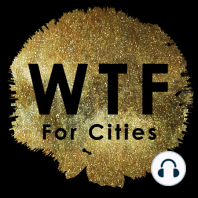11 min listen

137R_Quantifying life quality as walkability on urban networks: The case of Budapest (research summary)
137R_Quantifying life quality as walkability on urban networks: The case of Budapest (research summary)
ratings:
Length:
9 minutes
Released:
Jun 12, 2023
Format:
Podcast episode
Description
Are you interested in how walkability and quality of life are connected?
Summary of the article titled Quantifying life quality as walkability on urban networks: The case of Budapest from 2019 by Luis Natera, David Deritei, Anna Vancso, and Orsolya Vasarhelyi, presented at the International Conference on Complex Networks and Their Applications.
This is a great preparation to our next interviewee in episode 138, Luis Natera, who talks a lot about urban mobility systems in the interview as well.
Since we are investigating the future of cities, I thought it would be interesting to see how we can quantify urban walkability. This article presents how to measure urban network walkability and its impact on quality of urban life, through the case of Budapest.
As the most important things, I would like to highlight 3 aspects:
Investigating urban walkability can highlight important factors to consider for urban decision-makers and designers for improving the quality of life.
Since the walkability of a neighbourhood is highly correlated with its liveability, both long distances and the lack of amenities affects suburban habitat lives negatively.
Designing compact, liveable neighbourhoods, considering also the upcoming environmental crises is the number one priority of many cities worldwide.
You can find the article through this link.
Abstract: Life quality in cities is deeply related to the mobility options, and how easily one can access different services and attractions. The pedestrian infrastructure network provides the backbone for social life in cities. While there are many approaches to quantify life quality, most do not take specifically into account the walkability of the city, and rather offer a city-wide measure. Here we develop a data-driven, network-based method to quantify the liveability of a city. We introduce a life quality index (LQI) based on pedestrian accessibility to amenities and services, safety and environmental variables. Our computational approach outlines novel ways to measure life quality in a more granular scale, that can become valuable for urban planners, city officials and stakeholders. We apply data-driven methods to Budapest, but as having an emphasis on the online and easily available quantitative data, the methods can be generalized and applied to any city.
Connecting episodes you might be interested in:
No.027 - Interview with Richard Manasseh about urban water management;
No.047 - Interview Hussein Dia about urban transport;
You can find the transcript through this link.
What wast the most interesting part for you? What questions did arise for you? Let me know on Twitter @WTF4Cities or on the wtf4cities.com website where the shownotes are also available.
I hope this was an interesting episode for you and thanks for tuning in.
Music by Lesfm from Pixabay
Summary of the article titled Quantifying life quality as walkability on urban networks: The case of Budapest from 2019 by Luis Natera, David Deritei, Anna Vancso, and Orsolya Vasarhelyi, presented at the International Conference on Complex Networks and Their Applications.
This is a great preparation to our next interviewee in episode 138, Luis Natera, who talks a lot about urban mobility systems in the interview as well.
Since we are investigating the future of cities, I thought it would be interesting to see how we can quantify urban walkability. This article presents how to measure urban network walkability and its impact on quality of urban life, through the case of Budapest.
As the most important things, I would like to highlight 3 aspects:
Investigating urban walkability can highlight important factors to consider for urban decision-makers and designers for improving the quality of life.
Since the walkability of a neighbourhood is highly correlated with its liveability, both long distances and the lack of amenities affects suburban habitat lives negatively.
Designing compact, liveable neighbourhoods, considering also the upcoming environmental crises is the number one priority of many cities worldwide.
You can find the article through this link.
Abstract: Life quality in cities is deeply related to the mobility options, and how easily one can access different services and attractions. The pedestrian infrastructure network provides the backbone for social life in cities. While there are many approaches to quantify life quality, most do not take specifically into account the walkability of the city, and rather offer a city-wide measure. Here we develop a data-driven, network-based method to quantify the liveability of a city. We introduce a life quality index (LQI) based on pedestrian accessibility to amenities and services, safety and environmental variables. Our computational approach outlines novel ways to measure life quality in a more granular scale, that can become valuable for urban planners, city officials and stakeholders. We apply data-driven methods to Budapest, but as having an emphasis on the online and easily available quantitative data, the methods can be generalized and applied to any city.
Connecting episodes you might be interested in:
No.027 - Interview with Richard Manasseh about urban water management;
No.047 - Interview Hussein Dia about urban transport;
You can find the transcript through this link.
What wast the most interesting part for you? What questions did arise for you? Let me know on Twitter @WTF4Cities or on the wtf4cities.com website where the shownotes are also available.
I hope this was an interesting episode for you and thanks for tuning in.
Music by Lesfm from Pixabay
Released:
Jun 12, 2023
Format:
Podcast episode
Titles in the series (100)
023R_Smart cities and disaster resilience (research summary) by What is The Future for Cities?